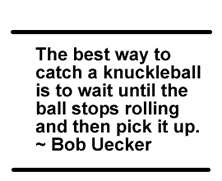Catchers: Tips, Drills, Information, Catching Equipment, Catchers Gear |
||||
Baseball-Catcher.com |
||||
Proper Receiving Techniques for a Catcher |
||||
|
Basic Skills Stance Setting Up Receiving Framing Blocking Throwing Leadership In-depth Skills Relays, Cutoffs, and Plays at Home Signals Calling A Game Catching Bullpens Covering Bases Pre-Game Routine Umpire Rapport Misc. Situations and Plays |
 Receiving is simply catching the ball. A good
catcher will make receiving look effortless. You need to have soft hands,
but at the same time be firm with your wrist and arm as you catch the
ball. Look the pitch all the way into your mitt. Your glove should not
move unless you want to move it.
Receiving is simply catching the ball. A good
catcher will make receiving look effortless. You need to have soft hands,
but at the same time be firm with your wrist and arm as you catch the
ball. Look the pitch all the way into your mitt. Your glove should not
move unless you want to move it.
Stick the StrikeIf a pitcher throws a pitch that you KNOW is going to be a strike, stick the pitch. A phrase I was taught and use repeatedly with my catchers is, "stick the strike." This means that your glove should not move in any direction (except a little back) after you catch the pitch. Hold the pitch where you caught it, BRIEFLY, then throw it back to the pitcher. For pitches low in the zone or breaking balls, sticking the strike is especially important. Catchers have a tendency to drop their glove in a downward movement after having caught a low or downward moving pitch. This is a bad habit and could cost your pitcher a called strike. Keep the ball in the strike zone. Stick It!Beat the Pitch to the SpotAnother phrase I use with my catchers that helps them with their receiving is "beat the pitch." As you are tracking the pitch with your eyes, you should have a good idea where the pitch will cross the plate and where you will catch it. With your mitt, beat the pitch to that spot. This will allow you to "stick" that pitch and the momentum of your glove is stopped. Stopping your downward glove momentum aids your ability to stick the low strike. DO NOT track the pitch with your mitt.High and Low PitchesA general rule for catching pitches that are high in the zone and borderline strikes/balls is to catch them as far back into your body as possible. Every pitch has downward movement, even fastballs. By catching a high pitch further back into your body you allow the pitch to drop. This provides the illusion of a strike that the umpire may call in your favor. This trick is especially useful with breaking balls.For pitches low in the zone, which are borderline strikes/balls, you want to almost attack them. Extend your arm to catch them while they are still in the strike zone. You need to be careful so your mitt does not interfere with the batter's swing. Also, you do not want to fall forward off your base.Remember for these low pitches: beat the pitch to the spot and then stick it. By applying these simple tricks for high and low pitches, you will get more strike calls for your pitcher. KEYS: Soft Hands, Firm Arm and Wrist, Stick Strikes, Beat the Pitch |
 OnBaseball.com | ||